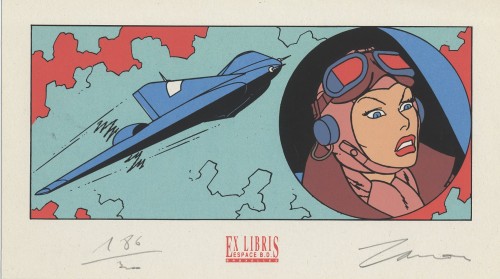lundi, 11 février 2013
The Comic Book as Linear Energy

The Comic Book as Linear Energy
By Jonathan Bowden
Ex: http://www.counter-currents.com/
Edited by Alex Kurtagić
Editor’s Note:
The following is excerpted from a book called Scum, written in 1992. It is part of a larger and wide-ranging, if perhaps unfocused, discussion on sado-masochism and the expulsion and conservation of energy. The text has only been lightly edited for punctuation, spelling, capitalisation, and grammar.
One of the most interesting and despised areas of popular culture is the “funny book” or comic—although the comic book itself has now become a prized form, with the original frames of Batman and Superman fetching large prices at Sotheby’s and other art dealers. The early comics, such as Batman and Superman, were staples of DC comics, based in the Rockefeller Plaza. They were adventure stories for boys, though comics were later to split along the styles of gender specification, and boys enjoyed superhero comics, perhaps War and Battle as well, while girls tended towards romantic comics dealing , in a crude way, with “human situations,” such as Cindy magazine. One can almost hear feminist devotees clucking in the background, but gender specification is an inalienable fact, a biological reality.
Nevertheless, Batman and Superman were subtly different from each other, and while Superman was more rugged, more all-American, Batman was darker and had more Gothic potential. Indeed, Batman was a mere mortal, unlike Superman, an expression of the vigilante urge in American society. In accordance with liberal stereotypes, of course, Batman was an individual who liked dressing in sado-masochistic uniforms and “beating the hell out of criminals.” He was obviously a man who showed “fascistic symptoms“—elements of pathological retribution, based on the murder of his parents, the Waynes. While Batman himself represented a dark, Gothic atmosphere, his villains, who reappeared in issue after issue, were his alter egos. Moreover, they appeared to be necessarily lightweight; they were villains of humor, charlatans of deviousness, like the Joker, the Riddler, and the Penguin.
The Joker is an interesting figure: a man who always murders his opponents with a smile on his face. This is basically because the smile, the broken leer, is unmovable; it was fixed there either by acid or a radioactive explosion, I cannot remember which—but, unlike Doctor Doom, the villain in The Fantastic Four, a Marvel comic which came along later, the Joker is not a genuinely tragic figure.
Doctor Doom, on the other hand, is a marvelous character, a man who has been terribly disfigured by a chemical explosion. As a result of this, he locks his face and eventually his whole body away in a suit of armour, later covered with beige cloth. Like The Phantom of the Opera in Gaston Leroux’s novel, no-one can see his face without being completely incapacitated—one of the reasons why it has never been shown in a comic panel.
In a sense, therefore, comic books represent orgies of violence, ugliness, meaninglessness, and sado-masochistic violence. Indeed, it is not surprising that Marvel Comics later introduced a character called The Punisher, first as a villain in Spiderman, and then as a hero or anti-hero in his own strip.
Marvel also brought out a highly sophisticated and degenerate comic called Deathlok, which featured a strange freak of science fiction: a half-human robot; a robot which was actually a reanimated and rotting corpse—the corpse of a marine commando, held in a metal casing and with part of its brain replaced by a computer (‘puter), with which the cyborg engaged in constant mental jousts.
As can be seen from the above, these comics were an amphitheatre of perversion, a cruel tourney, available in any dime house, over which children would pore for hours, much to the consternation of their parents. Not surprisingly, there are periodic attempts (by parents and guardian committees, watchdogs, and so forth) to ban or restrict the circulation of such material, and under threat by a Congressional committee that was concerned about “horror comics,” the industry bowed to the inevitable and introduced a voluntary body, the Comics Code Authority.
Of course, the whole purpose of comic books is that they are cruel “jokes,” violent forms of juvenilia, which focus and dispel the raw emotions of children. In a sense they are the violent fantasies of children, where no-one is ever hurt and everyone picks themselves up at the end of the day. Hence, we see the purposeless energy, the violent and contrary lines of force that comic books represent. They are festivals of line, disorientated patterns of force—just look at the Modesty Blaise strip by Peter O’Donnell, for instance, and you will realize that they are the sine qua non of Right-wing art. They are a festival of linear force—nothingness, despair, redemption, where redemption involves commitment, in the Sartrean sense, nearly always through violent action. This is the type of act represented by Rapeman in the Japanese adult comics known as Manga, where beautiful and dreamy oriental women, drawn in outline, are sexually assaulted and murdered by Rapeman. Moreover, such draughtmanship always accentuates the sexual organs of women, as in the Vampirella strip, for example.
The Vampirella strip, in particular, dealt with the adventures of a scantily clad Transylvanian countess. In many respects, it was an attempt to corner two markets at once: namely, the market for horror stories, on the one hand, and the market for soft pornography, on the other. Moreover, you can be sure such comics were not licensed by the Comics’ Code Authority.
http://www.wermodandwermod.com/newsitems/news020220131828.html [2]
Article printed from Counter-Currents Publishing: http://www.counter-currents.com
URL to article: http://www.counter-currents.com/2013/02/the-comic-book-as-linear-energy/
00:04 Publié dans art, Bandes dessinées, Nouvelle Droite | Lien permanent | Commentaires (0) | Tags : jonathan bowden, bande dessinée, art, 9ème art, nouvelle droite britannique |  |
|  del.icio.us |
del.icio.us |  |
|  Digg |
Digg | ![]() Facebook
Facebook



Les commentaires sont fermés.